Text
June 20- Osaka Day Trip


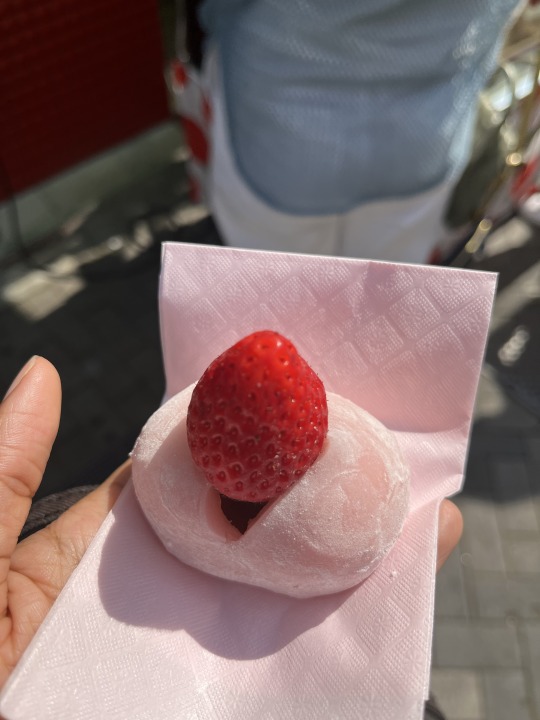
We had our last excursion today! We went to Osaka today and visited Osaka Castle and American Village. First, we ate at McDonald’s and I got the same thing that I got the first time I went to McDonald’s; an egg sandwich, fries, and an apple pie. I stand by my statement that McDonald’s in Japan is better than McDonald’s in the States. Afterward, we went to Osaka Castle, which was still cool even though it wasn’t as big as Himeji-jo. I wish I went inside the museum there but I enjoyed the other museums that we’ve gone to so I don’t really regret not going in. American Village was a lot different than I expected it to be. I expected it to have a more “patriotic” feel like having more American flags and things that represent general stereotypes from the U.S. It was actually a lot more urban than I thought it was going to be. It seems that it took a lot of inspiration from American TV shows and their settings. I even saw a store that had a lot of pop culture merchandise; it had a cool Fresh Prince of Bel-Air varsity jacket. The last place we went to was a shopping plaza nearby. The 3D ads that were there were fun to look at. I got a strawberry daifuku for the first time and it tasted amazing! It was a bit sad to hear that we were dismissed for the last time though! I’m really thankful for the experiences and people that I’ve met on this trip and I’m glad that I was able to go on this trip!
In the reading, I found it interesting that a lot of older buildings in Japan are being abandoned and unutilized in favor of modern structures. It related back to some of my personal experiences because it reminded me of a popular Japanese realty Instagram page. It features a lot of older model homes that realty companies are selling at cheap prices. It seems that even though older buildings are being abandoned, other people, specifically foreigners, still want to utilize these buildings as vacation homes. Also, the article reminded me a lot of an earlier article we read about Japanese urban planning.
It was also surprising to find out that Osaka was mostly an industrialized city when it was first developed in the modern era. I originally thought that it followed Tokyo’s development model and became urbanized through its neighborhood development and better, accessible technology. I wonder if Osaka was one of the first cities to be industrialized because it was far enough from the capital for factories and other businesses to develop. It’s also interesting to think about when Osaka started to become more urbanized and less industrial. I enjoyed learning more about the development of Osaka and it was cool to learn that it was mostly industrialized at first.
Thanks for everything and for reading this blog!!
0 notes
Text
June 19- Nara Day Trip
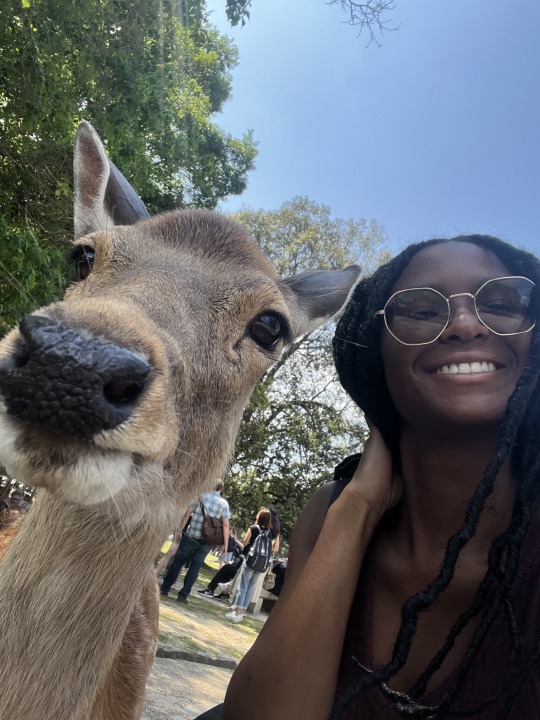
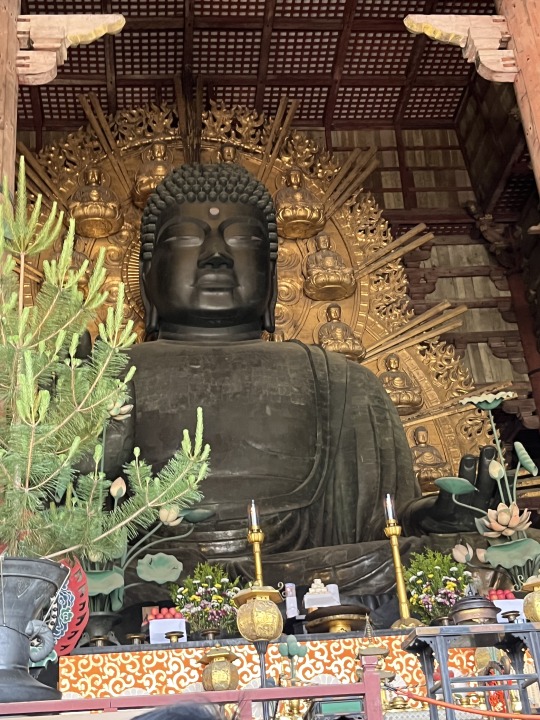
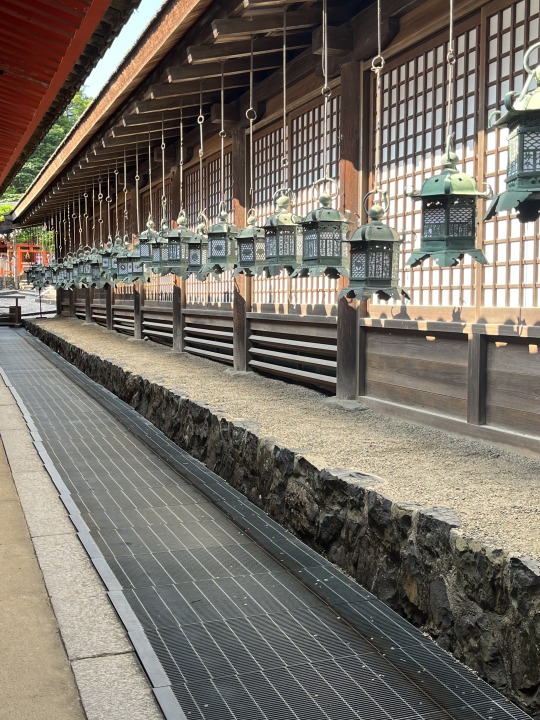
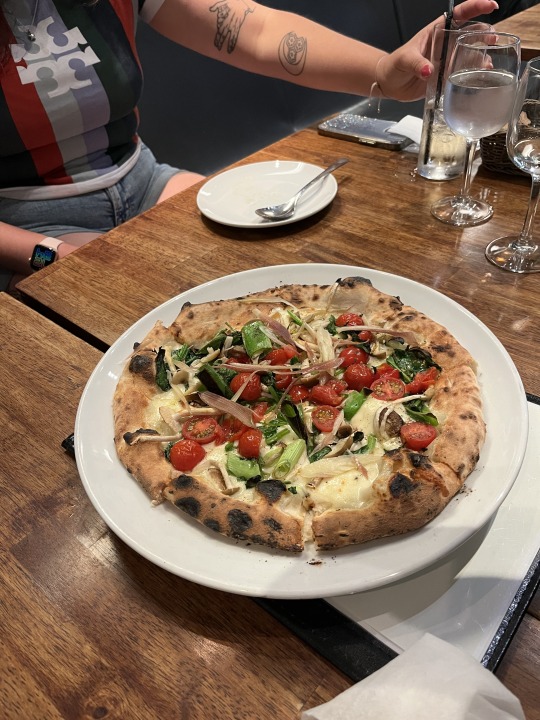
We had our day trip to Nara today! The ride there was nice, I was almost asleep by the latter quarter of the ride. For lunch, I went to a pizza place with some classmates. It was really good, we had a margherita and Yamato pizza. The Yamato pizza had seasonal vegetables from Nara as toppings. I liked it but it had a strong onion/garlic taste to it so I liked the Margherita more. I had a lot of fun at the deer park once we got there! As soon as I got some rice crackers, three deer just ganged up on me! One even bit my sweater when I wouldn’t give it any😂. After they took all my crackers, I went around petting them until I decided to get some more crackers. They lasted a lot longer this time because I broke them up instead of giving the deer whole crackers. It was less stressful this time getting chased around by deer. After the deer park, I enjoyed seeing the Daibutsu and getting to go through his “nostril”. At least I know I’ll have a good rebirth now! After the first temple, we went inside the Todaiji Museum. My favorite part of the museum was the Buddha sculptures. I love seeing them every time we go to museums. I think the work that the artists put into them is so impressive! After the museum, we went to our last temple on the trip. I liked going through the lantern room and the illusion they had with the mirrors in the room to make it look like they had more lanterns. After we were dismissed I went to the love shrine to pray for my friends’ love lives more and got ice cream. I just returned to the ryokan after that, so I just relaxed after our day trip. I’m a bit sad we went to our last temple today though, I enjoyed visiting them, even with all the stairs we had to climb sometimes 😂
The readings helped me understand the excursions and the statues we saw more. I find it interesting that despite Vairocana being the Buddha that represents emptiness the statues built of him are so grand to hopefully interpret what he might actually look like. I also found the denomination of Mahayana Buddhism on the historical Buddha to be similar to Christianity and how Jesus’ existence is viewed. Both believe that a special figure was placed on earth to spread the word of their respective religion. This comparison just interested me because it was another similarity between Buddhism and Christianity that I found. It makes me more curious to learn more about Buddhism and other possible similarities the two religions may have.
It was also interesting to find out that in order to reconcile the discourse amongst believers of Shinto, Buddhist priests stated that Shinto kami were just manifestations of Buddhas. I wonder how followers of the Shinto religion interpreted this because I imagine it would be difficult to accept this statement at first, especially toward a religion that some of them may not have heard of or may already hold negative perceptions against. The history of Buddhism is fascinating to read about and I hope to learn more after this class ends.
0 notes
Text
June 18- Kyoto Manga Museum
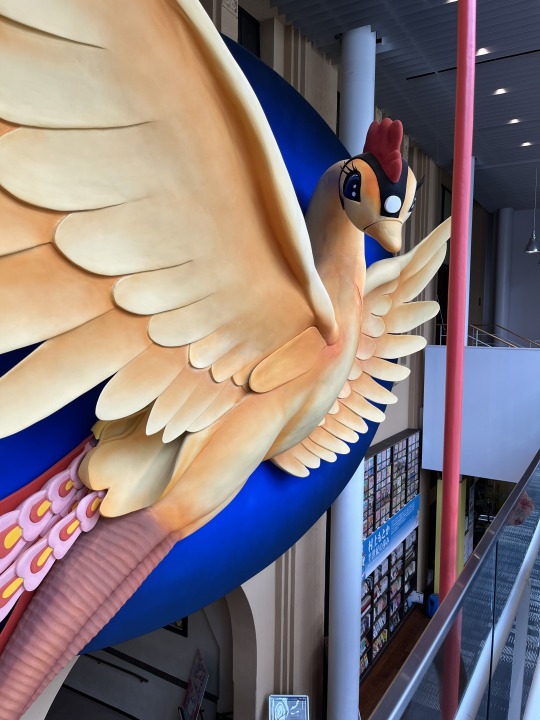
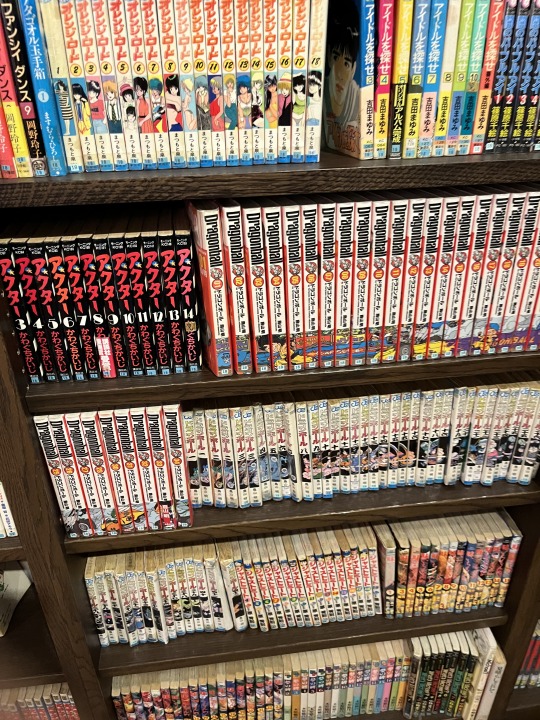
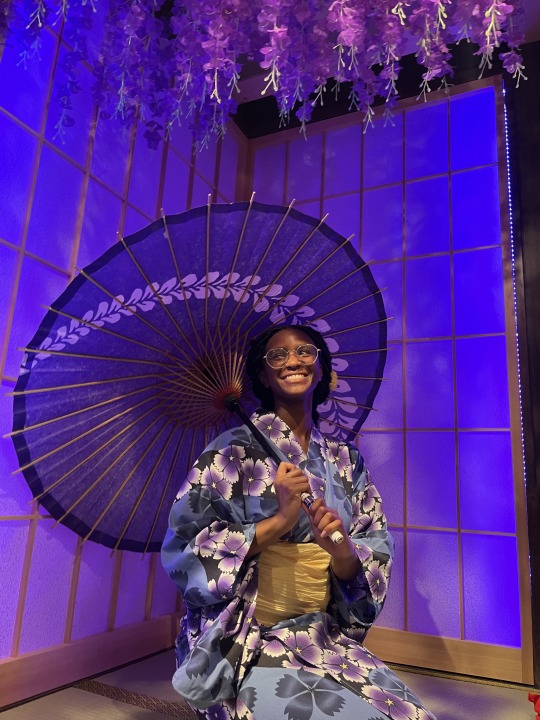
Today, we went to the Kyoto International Manga Museum. Overall, I enjoyed all of the exhibits and the show that we were able to see. I think that it’s cool that the museum also functions as a massive library of manga starting from the early 1900s and onwards. I wonder if the manga there are donated or if the museum purchased them. It was cool to find out that the building used to be a school and that the museum dedicated some exhibits to pay homage to the school that used to be there. My favorite exhibits were the History of Manga exhibit and the hands exhibit. It was cool to see the hands of so many prominent mangaka who visited the museum. I wasn’t able to find any of my favorite authors though. In the History of Manga exhibit, I liked going through the timeline of the development of this medium from past to present. They also showed a breakdown of how mangakas get paid and included the expansion of manga into different art forms such as video games and cosplays. It was also nice seeing some of my favorite mangas in the exhibit. The Kamis show we saw after looking through the museum was very entertaining. The presenter was hilarious and I enjoyed the quizzes and stories that he showed. The joke about his mom was a really funny note to end on. After the manga museum, I had a reservation at a kimono rental place with some classmates so I went there. It was cool seeing and experiencing how yukatas are put on. I was a bit worried about the hair portion though because the stylists themselves looked worried😭. It turned out well though, so I thought it was nice that they still tried and were able to do well! After everyone was dressed we ended up spending half of our rental time taking pictures at the photo op in the ryokan. After that, we went to the temple across the street and took pictures there as well. Even though yukatas are lighter kimonos, it was still hot, so I couldn’t imagine wearing one all day or during our excursions😭. Afterward, I got Indian food nearby and relaxed in my room. It was another great day!
The reading and the exhibit helped me learn more about the history and add context to some of the exhibits I saw as well. In the main exhibit hall containing information about the history of manga, I saw the term “serialization pauper”. This described how mangakas who have their works published in serialized magazines earn very little money from these magazines due to the wide distribution of profit to the people involved. I wonder why mangakas still have their works included in these magazines despite the little profit they receive. The popularity of these serialized magazines may help the artist’s work become popular enough that they would be able to receive profit by having it adapted in other mediums such as anime and video games.
Another thing that I found interesting from the reading that was elaborated on in the museum was the division of manga themes. One theme that I didn’t find in the reading was seinen, which the manga museum defined as having a demographic of young adult-adult men. I found it interesting because of the relationship between the genres of seinen and gekiga. Both tackle more mature themes and feature mature content. However, seinen tackles issues in a more fantastical setting such as Attack on Titan and Psycho-Pass. Although gekiga isn’t really popular anymore, I feel like the same themes formed the basis of the seinen genre, which is extremely popular today.
0 notes
Text
June 17- Free Day
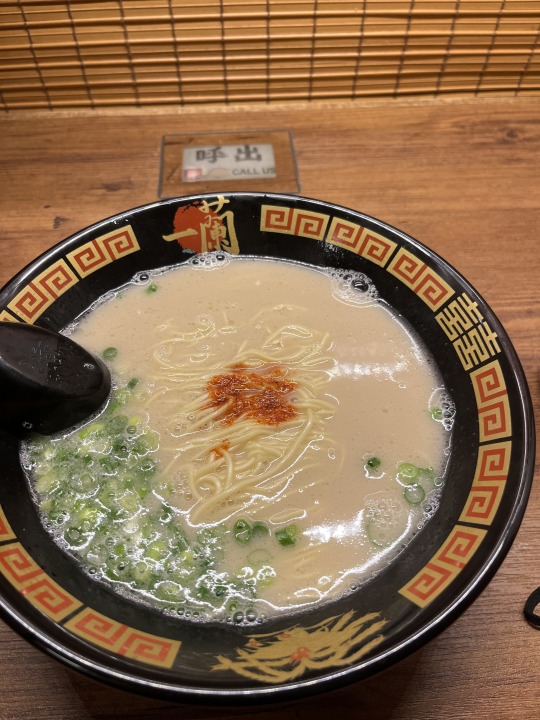
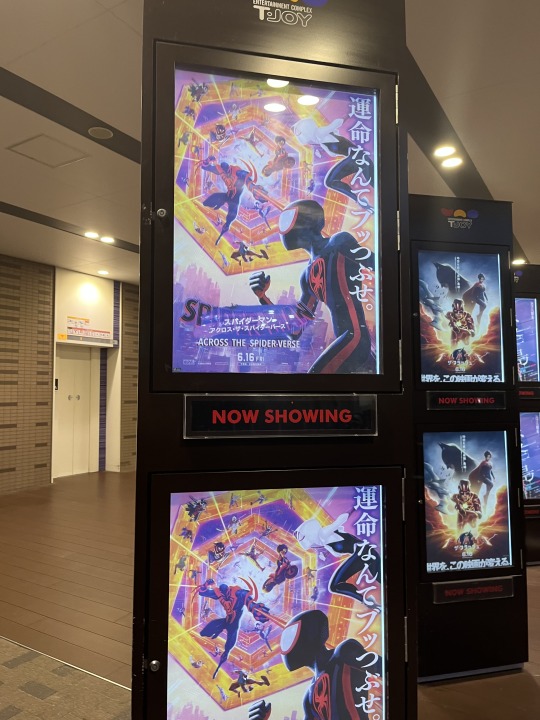
For our last official free day, I didn't do that much. I went to Ichiran ramen and the movie theater. Ichiran ramen was a cool experience. I was surprised about the wait to get in; I ended up having to wait 40 minutes to be seated with one of our classmates. The wait didn’t feel that long though, the employees were able to seat us after about 30 minutes or so. I like how I was able to customize my order by choosing how much I wanted for each of the signature ingredients. They also had another ordering form at the booth if I wanted to order more. The ramen itself was good; I wish I ordered more spice and noodles though. After eating there, I met up with more of our classmates to watch Spider-Man: Across the Spiderverse. I was really excited to watch the movie because Spider-Man is one of my favorite Marvel characters and the movie had already come out two weeks ago in the States. I was finally able to stop dodging the spoilers I would see on my For You Page on Instagram! The movie itself was amazing, I enjoyed the plot, characters, and animation and I can’t wait for the next movie to come out next year! It was also interesting to see Japanese theater etiquette and compare it to American theater etiquette. During the movie, it was quiet the entire time; other attendees didn’t visibly react to any of the scenes. They also stayed throughout the entire credit sequence, whereas some people in the States would immediately leave after the final scene in the movie. It was interesting to note the differences between both experiences back home and here. After the movie, I ended up walking back to the hotel and finally talking to my brother about the movie. I can’t wait to rewatch it when I go back home!
0 notes
Text
June 17-Arashiyama Bamboo Forest
We went to the Arashiyama Bamboo Forest today. When we arrived there, I didn’t expect it to be so crowded but it is a big tourist area so I wasn’t surprised after I remembered that. Visiting the love shrine was fun; I didn’t wish for anything personally, but I did pray for my friends’ love lives though. I thought the overall forest was really beautiful and I wish that I walked through it more, but I might use my last day to go back and look through it more. For lunch, I went to the tofu place that Leina showed me. The food was really good, I got a lot for a cheap price. There was only one part of the meal that I didn’t like, which was this grey piece of tofu which had a bland, earthy taste to it. I tried it with wasabi to see if that would be any better but it wasn’t 😭. After eating at Sapo Tofu Ine, I got sakura ice cream, which had a surprisingly cinnamon-like spice to it. I expected it to be more sweet than have a sort-of spice to it. The monkey park was also really fun; I hated the small hike it took to get there though. I think I was tired out from all the hikes that we did previously, I didn’t want to climb any more hills😭. Once we got to the top it reminded me of Mt. Takao where you could see a bunch of landmarks. I enjoyed looking at the monkeys and trying to see which landmarks I could spot from the guide at the top. On the way back down, I played on a see-saw for the first time! It was creaking the whole time though, probably because it was a bit old. It was probably a bit funny for other people to see college students playing on a see-saw 😂. After I got to the bottom of the mountain, I went rowing with Sumi at the river we passed by before we separated for lunch. It was difficult to say the least. I’ve been kayaking before but never rowing. When we first started, we didn’t really move anywhere. After we finally started moving, we hit the shore not too long after and a passerby had to help get the boat back out into the water. Besides the troubles we had, rowing was nice and I would do it again now that I have a bit of experience! After our rowing experience, Sumi and I got honeycomb ice cream. I tried eating the honeycomb but soon realized that was a mistake since I didn’t like the waxy texture. It was a good day overall; my favorite part was the rowing experience I had!
I think that the history of Arashiyama is really interesting; it was originally a farming area but turned into a scenic forest later on. Arashiyama was able to come from humble beginnings and eventually became the extremely popular tourist spot that it is today. I think that it’s cool that Arashiyama is designated as a protection and scenic forest. I’m interested in how Japan went from overutilizing the natural resources that it had to being able to replenish and maintain the resources that they used over time. I enjoy learning more about environmentalism, so it’s amazing to me that Japan was able to have such as great turnaround in how the land was utilized and treated. The first article made me curious to read more about other areas similar to Arashiyama and Japan’s views on environmentalism.
I also enjoyed how the other two articles we read gave more insight into the Tale of Genji. It was cool to see one of the actual sites where the novel takes place. Reading more excerpts of the novel and being able to read about some of the real-life inspirations and locations from the novel inspire to try to read the novel in its entirety. I know that it’s a long novel but reading more about it makes me want to attempt reading the whole thing.

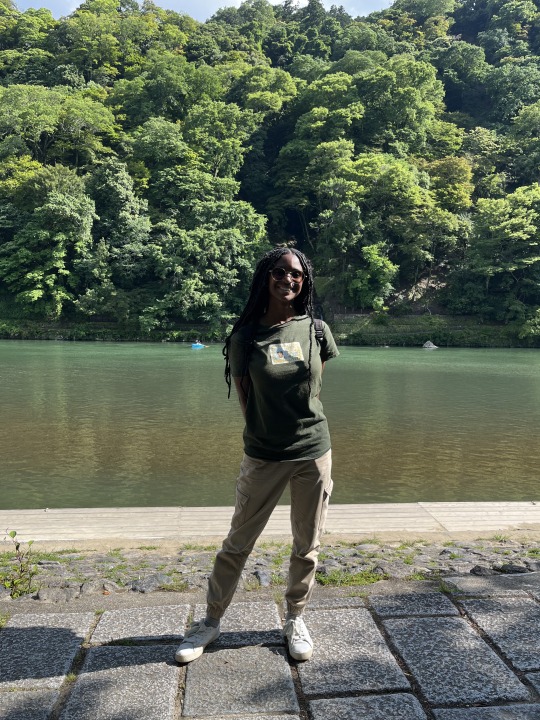
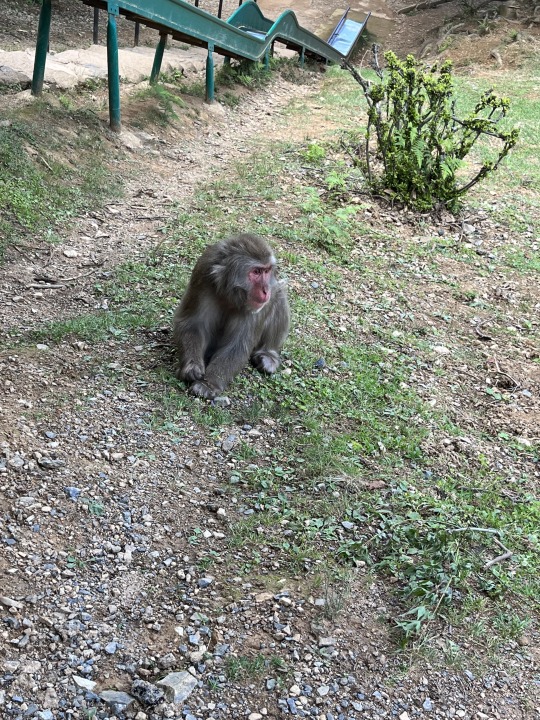
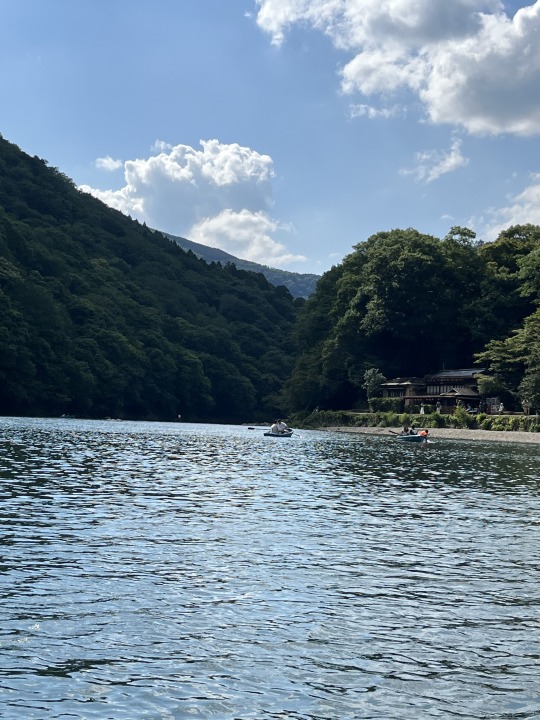
0 notes
Text
June 16- Kyoto National Museum/ Kyoto Imperial Palace
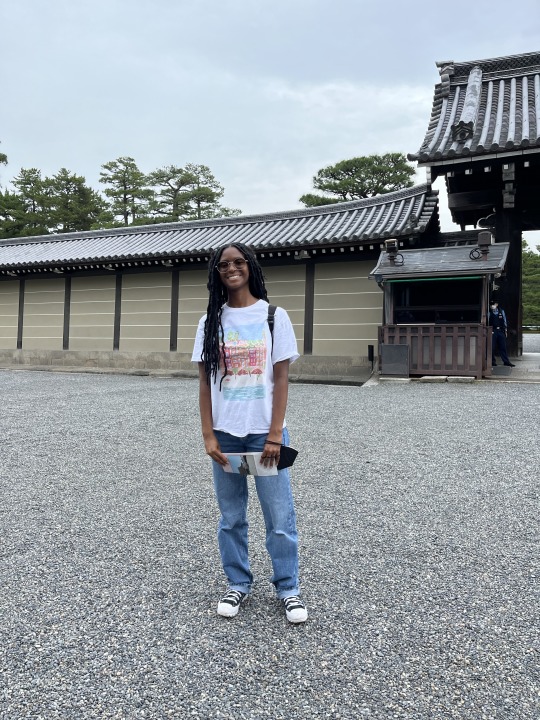


We went to the Kyoto National Museum and Imperial Palace today. I enjoyed both excursions, especially the Kyoto National Museum. I liked going through all of the exhibits; my favorite exhibit was the Buddhist Sculpture exhibit. All the sculptures in the exhibit looked amazing, especially the main six at the front of the room. The amount of detail carved into each sculpture was incredible to see; they were able to carve a life-like and flowing quality to the clothes each sculpture was wearing. My second favorite exhibit was the poetry display on the second floor. I thought the patchwork of some of the poems there were really beautiful. After the museum, we took a break for lunch and I went to an okonomiyaki place at the station. I thought it was good that the place had vegetarian yakisoba so that I didn’t have to eat around any meat😂. The last place we went to was the Kyoto Imperial Palace. It was nice that we were able to get a tour of the palace grounds and learn more about each building and their development as well. I enjoyed the garden the most and now the public garden was designed to be enjoyed from multiple perspectives. I also like learning about the roofing technique that was used for all the buildings in the palace. I like how the tour guide noted that it was environmentally friendly since carpenters would just shave the tree bark off. It was also nice to see the varying levels of thickness that each building would use and how durable the roofs were as well. After today’s activities I ended up going to Baskin-Robbins again and went shopping a little bit. I enjoyed the rainbow sherbet that I got but I wish I got something else😭. It was another nice day.
For my exhibit, I chose the Jizo statue with the lotus dais and the wooden Jizo statue that were on the far end of the first exhibit. The lotus dais statue was constructed out of metal, bronze I believe. The statue was wearing flowing robes and had a ring with branching rays behind its head. The second statue was similar except it was constructed of a bright-colored wood and the ring behind Jizo’s head didn’t have any rings branching out. These statues stood out to me because it reminded me of some of the paintings that I’ve seen of figures in Christianity. I’ve often seen figures such as Jesus Christ, the Virgin Mary, and others who have a halo behind their head. I’ve seen that it’s meant to signify the divine or spiritual energy from those figures. I’ve also only seen it on the more significant figures within Christianity. I thought it was interesting to see the same symbols in Buddhism as well, which would make sense due to Jizo being a prominent figure in the religion.
The reading didn’t betray any of the thoughts that I had when seeing the Imperial Palace. The palace had a mostly minimalistic aesthetic that was described in the reading. Most houses had only small furniture that could be moved around. I was a bit surprised about the tatami mat rooms that we were shown though. In the reading, typical houses would only have straw mats that family members could move around. This did make sense due to the Imperial Palace not being a typical house and most likely not following what many typical houses may have been doing at that time.
0 notes
Text
June 15- Fushimi-Inari Shrine

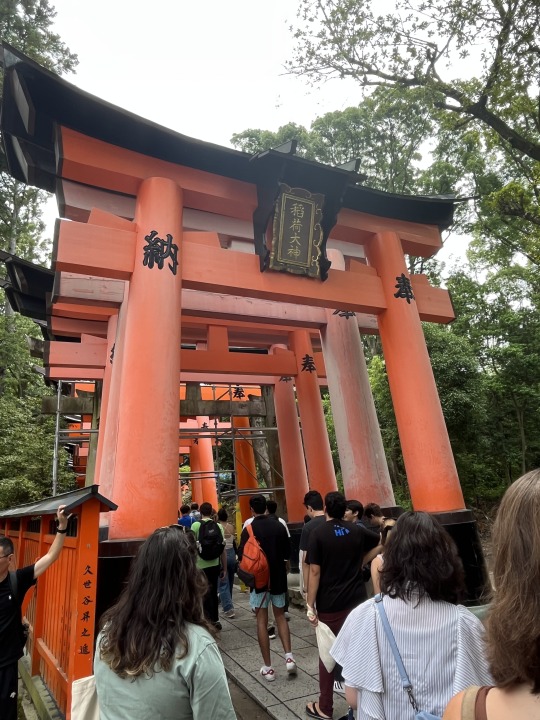
Today we went to the Fushimi-Inari shrine. I was looking forward to this hike as well because I enjoy being outside in general. It was also interesting to learn about the stones and how they were able to grant your wish if the stone was lighter than what you thought. I honestly thought that the stone was going to be really heavy because the people who went before had a lot of trouble lifting the stone. Surprisingly, when I lifted the stone it was lighter than I thought. My arms aren’t strong so I thought I was going to struggle a lot more lifting it. At least that means my dream is supposed to come true! The rest of the hike to the midpoint wasn’t too bad, it was just a lot of stairs😭. I decided to keep climbing to the top after we were dismissed and the way up was nice. When I reached the top I was surprised to see a lot of smaller Inari shrines. There were over 100 of them there. After wandering around the top for a little bit, I went to a cafe at the bottom to eat. I got a beet potato salad sandwich which wasn’t too bad, the walnuts and raisins that were in it just added a weird taste to it. I went back to the hotel after that so today was nice, I enjoyed hiking again.
The reading made me curious about the interpretation of Inari. It’s interesting that most priests agree that Inari isn’t a fox, but this symbol is the one that’s most prevalent to the god. I wonder if priests allow this image to be used at shrines because foxes are seen as the messengers for Inari or if they don’t like the fox being used at all. It’s also fascinating that Inari also has no central definition but multiple interpretations of it. People are still able to worship this god but may not agree with everyone’s interpretation of it.
It was also cool to read about how Inari’s purpose has changed over time. Although Inari is still an agricultural god they now also have the purpose of bringing people business success. I think that’s interesting because once more people started branching out into careers outside of agriculture, patrons probably still prayed to Inari despite their career change and we’re able to extend Inari’s purpose into overall business success. It was cool seeing how many businesses had donated money to the Fushimi-Inari shrine to have their own torii gate built there. Some businesses even have small shrines in their store that their employees will pray for a successful day, so it’s interesting to see so many businesses donating to the shrine to hopefully have a successful business. I wonder if they continually donate to the shrine as well?
0 notes
Text
June 13- Universal Studios Japan (Independent Excursion)

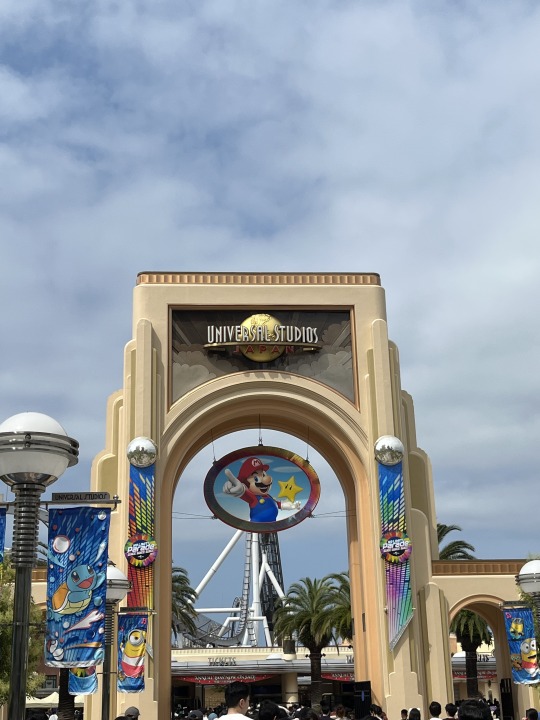
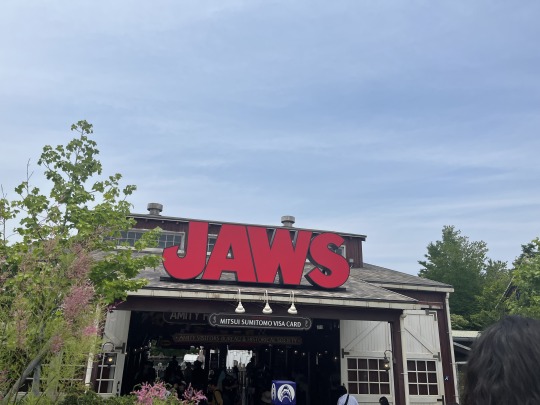
Today was our second to last free day and we decided to go to Universal Studios Japan! I was excited about some of the rides there, especially the Mario Kart Challenge and both of the Harry Potter rides. I was also really excited to ride Jaws because it’s the last remaining Jaws ride in the world! I was really debating whether or not I should go on the Hollywood Dream roller coaster since it looked fun but also looked really intense. In the end, my fear won and I ended up not going on the ride. The screams and drops were getting to me too much for me to ride it😭. My favorite rides were Spider-Man: 4D and Flight of the Hippogriff even though the latter was so short. The Spider-Man ride was more entertaining than I had found it in my previous times riding it because of the other guests we rode with. Besides me and three of my classmates, the car was mostly full of middle school girls. They seemed so shocked and scared throughout the whole ride; they were screaming at most of the jump scares and sudden movements in the ride. It was honestly kind of funny because I never expected anyone to be scared of a simulation ride like this one. So seeing them experience the ride for possibly the first time was really funny and made the ride even more entertaining for me. I was actually surprised that I like Flight of the Hippogriff because I normally hate any and all roller coasters I’ve forced myself on. However, I wanted to go on this one since it didn’t seem too intense and I want to start building up my tolerance to roller coasters little by little. I was a bit anxious at first sitting in the middle row waiting for the ride to start, but one girl waiting at the gate made some small talk with me which helped me calm down a bit before I jolted forward as the ride started. At first, I started screaming as we were going down the drop but right after that I just started laughing at how fun the ride was. It was super short but helped me lessen my fear of roller coasters a tiny bit. I also got to see the same girl who calmed me down as she finished the ride, which was nice. I enjoyed going to Universal, but to be honest, I prefer Universal in Orlando because they have a lot more rides I can go on😭. I still love Universal Japan though❤️!
0 notes
Text
June 12- Kiyomizudera/Gion Tour
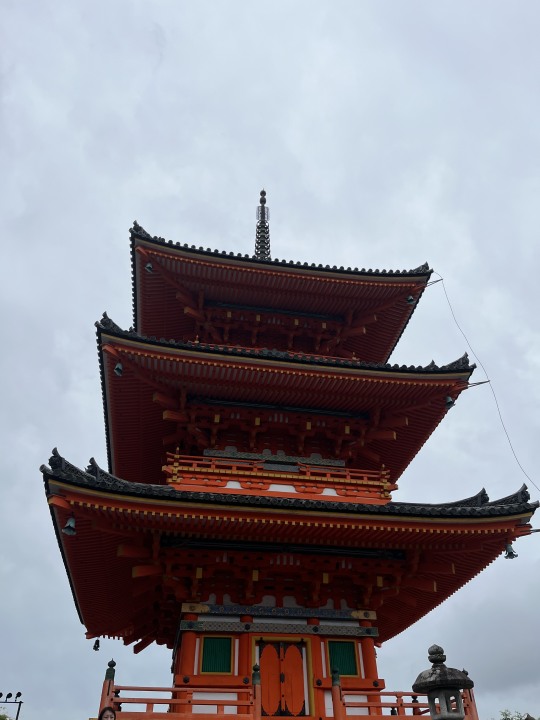
Today we visited Kiyomizudera and Gion. We faced the same problem with buses again; fortunately, I was able to ride the bus instead of walking to the temple. Naomi told me that NHK or another news station had covered the issue of foreigners taking up a lot of space on public transportation, which was causing problems for locals. So that may be one of the reasons why we have so much trouble getting on buses, along with so many students taking trips here. Once we reached our stop, I got some tanghulu from a stand nearby another shrine. I enjoyed it, but not as much as I thought I would. I didn’t like the tanghulu grapes, probably because they were so soft. The strawberries were good though and I would probably get another tanghulu with only strawberries. The temple itself was beautiful; it reminded me of Himeji-jo in the way that the temple’s structure was spaced out into multiple buildings. One unfortunate thing that happened when we first got to the temple was when I got called a racial slur. I was pretty shocked about it at first and am still a little bit mad about it. Part of me wishes that I had said something to them but it’s not like it would have helped anything. I’ll get over it soon enough though. Other than that, the best part of the shrine for me was the tunnel that we went through. It was interesting having to navigate the tunnel in complete darkness and only seeing light at the stone and the end of the tunnel. I only wished for success with my goals for this year and peace of mind; I already know that my senior year is going to be stressful :(. I also enjoyed walking through Gion and actually going to the traditional house Starbucks there! I was able to sit inside the store where most of the area had tatami mats. I enjoyed this Starbucks a lot more than any Starbucks back at home, to be honest. I liked their system of having two separate areas for ordering and creating drinks, it helps to lessen crowding within the store. The show that we went to was also entertaining. I was surprised that the first three acts were almost simultaneous, it threw me for a loop for a bit. My favorite parts of the show were the Kyogen comedy and the Kyomai dance. The actors were funny in the play and I thought the dance was extremely beautiful. The overall program is a great way to introduce people to traditional Japanese culture in a short time span, which is great for students since a lot of us have a short attention span anyway. I enjoyed our activities today and hopefully, I‘ll get to go back to Gion before we leave so that I can explore the area more.
The first reading made me appreciate Kiyomizudera more, especially the tunnel and the waterfall. It’s interesting how when people go up to the waterfall hoping for some form of luck or success from one of the three streams, they don’t which one they’ll be blessed with. Even if someone wanted luck in all three areas, they could only pick one or they would be deemed greedy and not receive anything at all. I see why this temple is known as the best one to have one’s prayers granted due to both the three streams and the opportunity to be reborn from Kannon. Patrons have multiple opportunities to have their prayers heard and granted by Kannon. However, is it expected that patrons go through both actions of going through the tunnel and drinking from the stream or is it greedy to take part in both?
The second reading caused me to be more curious about the occupation of a geisha. Before I learned more about geisha and the red light district, I just thought that the district was just for typical sex work and nothing more. However, after reading the article, I see that the district was much more than that. The geisha present then and now are highly educated and were hired for events that allowed them to demonstrate the skills they gained in the arts and discuss various topics with their customers. I also wonder if male geisha will ever become an occupation again. I don’t think it really will because based on how they were described, male geisha wouldn’t really serve much of a purpose now if it’s just to keep a party going. It would be useful to show a part of traditional culture, but I don’t see it serving a functional or significant cultural purpose now.
1 note
·
View note
Text
June 8- Ghibli Museum (Independent Excursion)
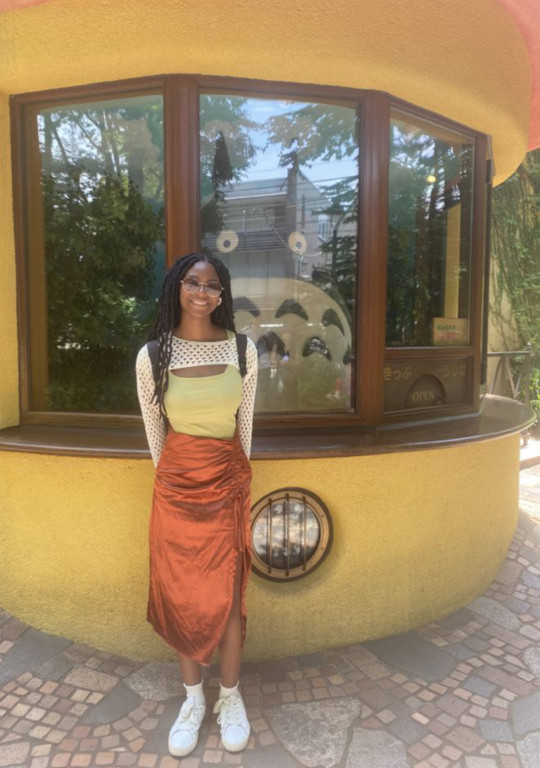
For our free day, we went to the Ghibli Museum in Mitaka! I was really excited about this free day since I love Ghibli movies and wanted to see more of the history and process behind the movies. The outside of the movie was very reminiscent of the style that Miyazaki had become known for over the years. I was able to take some pictures of the exhibits outside of the museum, but they had a strict policy against pictures inside the museum. The museum itself consisted of four exhibit rooms, a theater, and a gift shop. My favorite exhibit was Miyazaki’s workroom. It was amazing to see his workspace and how much effort he puts into each of his works. His work studio was filled with books that he referred to and studied depending on what he was drawing. I thought it was amazing that he had gone through so many books in order to get everything right in his movies. Seeing everything from the shades of paint he used to the books and films he studied was inspiring because it showed how dedicated he is to his art and performing it to the best of his ability and research. Inside the theater, an exclusive short film was shown. It was about the Neko Bus from My Neighbor Totoro and I honestly thought it was kind of weird and creepy to learn more about Neko Bus’s family. I’ve never seen My Neighbor Totoro before, so that may be a reason why I was a bit weirded out since I haven't really seen Neko Bus that much. The museum also featured an exhibit about a cartoon that he directed called Future Boy Conan, which was a TV show that he directed before any of his breakthrough films. I thought it was interesting since Miyazaki had worked on quite a few shows prior to making his first big films, but this show had a big hand in his path that led him to where he is today. The museum visit inspired me to rewatch the Ghibli films I’ve seen and watch the others that I haven’t seen yet. I also want to look into Hayao Miyazaki more to learn more about his creative process and his inspiration to create films.
After the Ghibli Museum, I went to the Tokyo Dome and went to some of the attractions there. Half of them were shut down, which was unfortunate, but the rides I ended up going on were still fun. I rode on the Ferris wheel, an indoor rollercoaster, and a spin glider-type ride. I also went to a shooting gallery and a teacup ride. Even though I hate rollercoasters, I think that was my favorite out of everything I went on because of how we went backward the second time around. Overall, the museum and Tokyo Dome made my second free day a very enjoyable one!
Media Reflection
Studio Ghibli represents Japan by presenting a more fantastical depiction of the country. A lot of films by Studio Ghibli take place in settings inspired by actual Japan and experiences that Miyazaki is able to translate into his own work. Some more realistic depictions of Japan that have come out of Studio Ghibli include Grave of the Fireflies. This film and the short story it is based on had taken the events of World War II and added the perspective of two siblings trying to survive. The film depicted issues that the citizens and Kobe and surrounding areas had gone through after the bombing and the casualties that resulted from it. A more fantastical representation from Studio Ghibli would be Princess Mononoke, which was set during the Muromachi period. Although it added fantasy to the time period it took place in, it included aspects of Japanese culture such as Shintoism and other aspects that were present during the Muromachi period. The reality that I saw in the museum wasn’t much different than the representation that Miyazaki and Studio Ghibli puts out in their films. The museum itself had a wondrous feel to it that mixed elements from the real world with the imagination of Miyazaki. The representation that is present in Studio Ghibli movies is reasonable to some extent. I don’t believe that it can apply to all of the movies produced and animated at the studio such as Arietty and Earwig and the Witch. It can be applied to quite a few of their other films though including Howl’s Moving Castle, which included themes of pacifism, which is a big topic in Japan given that the country can only hold defensive power now and is no longer allowed to operate a military. There were no unexpected slippages between reality and the representation from Studio Ghibli, they were both a mixture of fantasy and realism, which is present in almost all of their films.
0 notes
Text
June 7-Mt. Takao
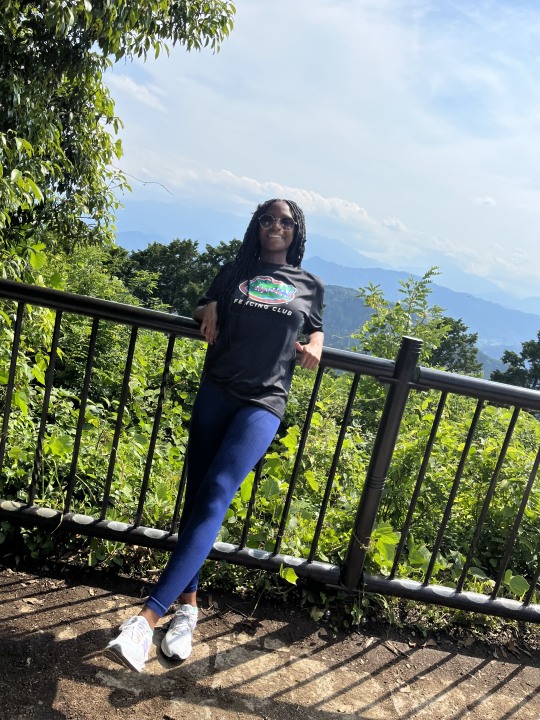
Today we hiked Mt. Takao! I was actually excited about this activity because I’ve never been hiking before and I like exploring nature parks and other areas like that. That attitude changed about halfway up the mountain. I didn’t expect that we would have go up as many stairs as we did that day, I was almost over halfway through because I was tired of going up flights of stairs. At least I wore hiking attire that day so I wasn’t too hot or uncomfortable. The first hour or so was really nice though. I got to go on a chair lift for the first time, which wasn’t as bad as I thought it was going to be. I’m scared of heights but I still wanted to go on it just to say that I experienced riding a chair lift. The ride was slow and peaceful, so I enjoyed that a lot. I was also able to get my stamp book and first stamp on the mountain! Now I can finally start my stamp collection! I thought the various shrines visited on the way to the top were nice and a good break from climbing the mountain. The view at the top of Mt. Takao was amazing! The view made all the climbing we did worth the effort. Even though it was cloudy, I could still Mt. Fuji a little bit, which was cool. I hope to climb part of it one day even though it’ll most likely be more tiring than Mt. Takao. In my opinion, the climb down was a lot worse than climbing up. The first half of the way down was quite nice, especially once we got to the suspension bridge. However, I regret not taking the chair lift down the second half. I hated walking/running down all the steep hills on the first trail! My legs hurt so bad, I feel like I’ve never regretted anything more on this trip than my decision to keep walking down the hill rather than getting a chair lift down. I ended up passing out as soon as I got back to the hotel that day. Despite my regrets on the mountain, I actually loved hiking the mountain and would do it again once I fully prepare myself 😂.
The reading didn’t betray any of my thoughts about my experience at Mt. Takao. I understand that the way Japan is now is due to many years of regenerative farming techniques. Would the forests at Mt. Takao be considered “protection forests” due to the shrines present? It would make sense if it did due to the surrounding woods functioning as protection from wildfires and other possible incidents.
The reading also made me curious about current farming techniques with the current situation of global warming. I wonder if Japan is altering its regenerative farming technique to plant more trees or plants that absorb more carbon dioxide to combat the levels of greenhouse gases that Japan emits. I also wonder if other countries have looked into this technique to help combat their carbon dioxide production levels. Although it is a small step toward taking care of rising global temperatures, if bigger corporations undertook this technique it might help since they have immense levels of carbon dioxide emission from factories. I enjoyed reading about how Japan was able to replenish its forestland over the years by implementing new and more effective techniques that took care of its needs without sacrificing all of its land.
0 notes
Text
June 11- Himeji-jo
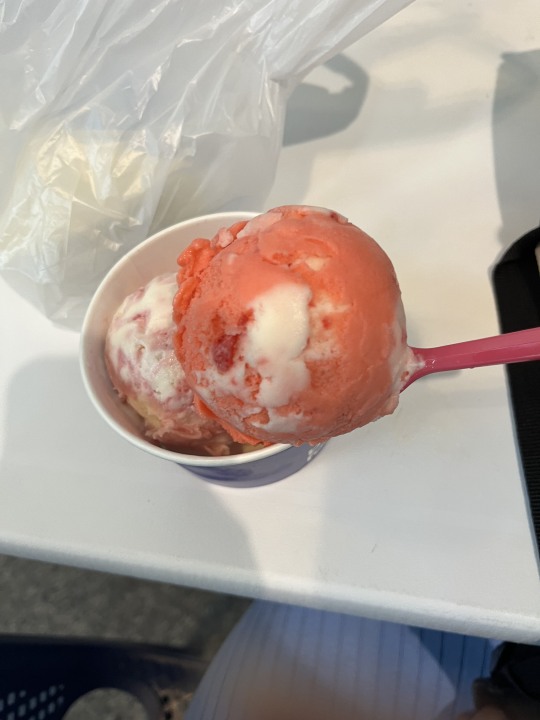
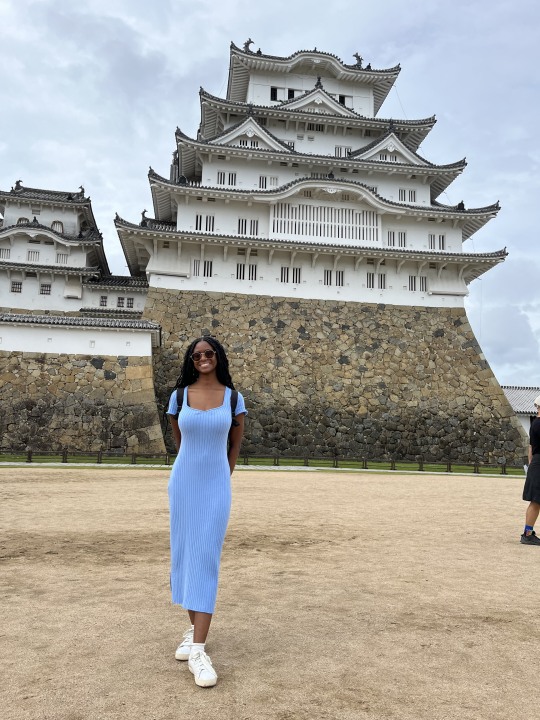
We spent the day at the famous castle, Himeji-jo, today. The train ride there was quite nice, that’s probably because I fell asleep for most of the ride to be honest. Once we got there, I went off with Leina and Naomi to get lunch and ended up at a takoyaki/yakisoba place. It turns out that the restaurant had been featured on NHK which would explain why it had been so busy. We also got Baskin-Robbins right after; that was my first time returning to Baskin-Robbins after ~2 years. It was sooo good though; I got the candy apple flavor and it was honestly the best ice cream I had in a while. I was also surprised that it had actual apple pieces and candy shards in there which added to how good the ice cream was. One thing that surprised me about Himeji-jo was the mini hike that we took throughout the castle grounds. It reminded me of Imperial Palace with the levels that they had concerning the defenses for both places. I enjoyed being able to walk through the buildings on the castle grounds, especially the main structure. It contained interesting stories about the inhabitants of the castle, including Princess Sen, and explanations on the techniques and materials generally used during that time. The story of Princess Sen was incredibly tragic to read through inside the castle. She was really only able to spend ten years of her life truly happy, with various tragedies, such as death, taking that away from her. One of the most enjoyable parts of the castle for me was the Okiku well. I love horror stories, so I was excited when I first heard the story during our class discussion. The story behind it frustrated me though; I would’ve haunted everyone in that castle if I had lost my life over a single plate. After exploring Himeji-jo, I explored a nearby shopping district but didn’t really go into any of the stores. I was hoping to go to Tegarayama Central Park, but most of the places I wanted to go to would have been closed by the time I got there. I also ended up getting Baskin-Robbins again after I got back to Kyoto; that ice cream was just too good!
The second reading helped me understand and visualize the design decisions that impacted the development of Himeji-jo. It’s interesting to see the influence from other places in the castle design, such as Europe inspiring the design and defense of the castle. This is evident through the noted reversal of techniques in Japan to use the already present height of the mountain and strengthen it by surrounding the area with stone. I also wonder how many earthquakes Himeji-jo has survived due to the curved sides that help the castle with weight distribution and assist with the decrease in damage from earthquakes.
It was interesting to read about the history and structure of castle towns in Japan. It reflected the residents that lived in these towns, from the carpenters to the ladies-in-waiting and handmaids that lived there. It was interesting to read how the daimyo initially controlled everything with the development of the town, but later just let the town grow organically as people started to move into the town. It showed how each party needed the other, which was noted in the reading. The daimyo needed the chonin to help grow the castle town and the chonin needed the daimyo to give them an environment to make a living. This was shown through the miniature model that the Himeji-jo site had of what the castle town originally looked like.
0 notes
Text
June 10-Kinkakuji/Daitokuji


We had our first cultural activity in Kyoto today. I thought that Kinkakuji was really beautiful. I also appreciated the pictures that were in the park that showed what the rooms would have looked like inside. After viewing the actual temple, I went through the rest of the park rather quickly. For lunch, Sumi and I went to a cafe down the street and I got fried rice with pickled vegetables. I wasn’t able to eat much of the fried rice though since there were bonito flakes sprinkled all over the top😭. What I was able to eat was still good though, so I was happy about that. I also saw the 大 character carved onto the nearby mountain from the cafe window. The cafe also had pictures from festivals that were held there too which was interesting. I also went to a souvenir shop below the shop where there were quite a few rising sun flags which were advertised as navy flags. Daitokuji was very fun to experience and look around. At the first temple, I enjoyed the tour and the explanation of each zen garden. I found it interesting that each stone represented something, with some even having names. I found it interesting how with each garden there would be more or less obstacles to signify the journey that Buddhists went through toward reaching Nirvana. It was surprising that we actually got to meet the former head priest of the temple as well. I wish I got his autograph but all I had on me were coins😭. After we were dismissed I ended up going back to the hotel since I still didn’t feel too well from yesterday. Hopefully, I actually feel better tomorrow.
The first reading by Mishima piqued my curiosity about Kinkakuji. The arsonist had felt so strongly about his idealistic version of the temple that he believed it had to be burned down so that he could focus on other things in life. I was curious to see previous images/paintings of the temple before it was burnt down and it didn’t look as bad as I thought it was going to be. The painting I found was from 1885 so there definitely was more deterioration between the time of the painting and the arson but the temple still looked beautiful in a more modest way than the way it was originally constructed. I wonder how the arsonist became so enveloped in his perception of this temple that he resorted to burning it down when it didn’t meet his expectations.
The controversy of Zen gardens was surprising to hear about since I didn’t realize it could be a controversial topic within Buddhism. Although Zen gardens are popular worldwide, it’s definitely most associated with Buddhism and Buddhist temples. Although one Japanese native stated that these gardens were just created to draw in tourists, the garden and its content fits in the concepts of Zen Buddhism very well. The tour we had at Daisen-in helped explain what everything in the garden stood for and how it related back to the principles of Buddhism and the denomination's stance on life.
0 notes
Text
June 9- Travel to Kyoto
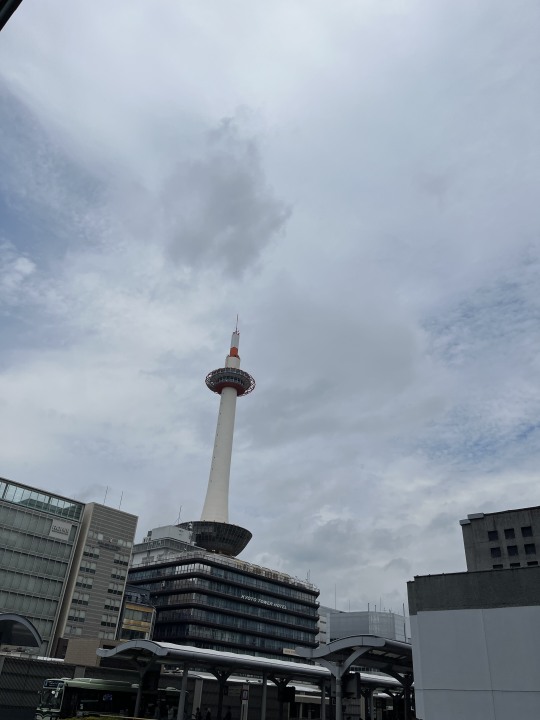
We finally arrived in Kyoto! Today we didn’t do any cultural activities; we spent the whole day traveling to Kyoto. I was a bit worried at first on the way to the Shinkansen since we got on the train during rush hour and we were having trouble finding spots on the train😭. Fortunately, we all made it on and got on the Shinkansen afterward. The Shinkansen itself was very nice and reminded me of the RomanceCar we took to Hakone. It’s amazing how these trains are able to move so fast and cut what would have been a 3-4 hour trip in half. I wish I had more to say about the train but I was asleep for most of the ride😅. Afterward, I just rested until the whole group was able to get to the station since I didn’t feel too well today. The ryokan that we’re staying at is very nice; I do like Hotel Edoya better though. Here we really only get two spaces which are the living/bedroom and the front space with the bathroom and closet. One highlight of my day after the train is that I got Pizza Hut! I got half Margherita and half Potato mayo corn. I wanted to try it after Leina said that potato mayo was her favorite pizza topping. It was actually really good; I’ve never tried kewpie mayo before so I didn’t know how it would be as a pizza topping, but it turned out well! Today was mostly a chill day since we spent the day traveling here, which is good since I don’t feel too well. Hopefully, I feel better tomorrow!
It was interesting to read about the history of the Shinkansen and its’ impact in today’s reading. It was cool to learn that Japan had originally wanted to expand its Shinkansen trail to South Korea and then Manchuria. I feel like it would have been profitable to have a Shinkansen line from Japan to South Korea since quite a few visitors come from there as well. I don’t think it would be feasible now however since it would be extremely expensive to build the trail needed to connect the two countries over the ocean. It was also interesting to read about the political connections within the rail system. Politicians would only bring railways to their constituents so they could see the “benefits of modernity” and have them keep the politician in their favor.
I’m not surprised at how cities would fight to have a Shinkansen station in their proximity since it was known to bring prosperity to cities that did have one. You can definitely see this impact in both Tokyo and Kyoto. Both cities hold a large population and are popular as well. It was unfortunate that some people would have their land taken away from them to build these stations though. It reminds me of gentrification in the states where many residents of an area will just be uprooted from their homes for more expensive, almost unaffordable housing will be built in their place. If Japan plans on expanding its trail, I wonder how the property owners would react any differently than their earlier counterparts.
0 notes
Text
June 6-Hakone
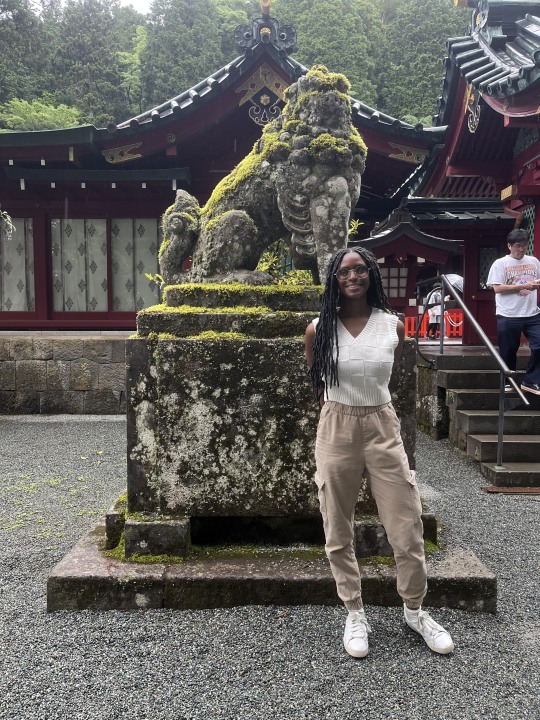
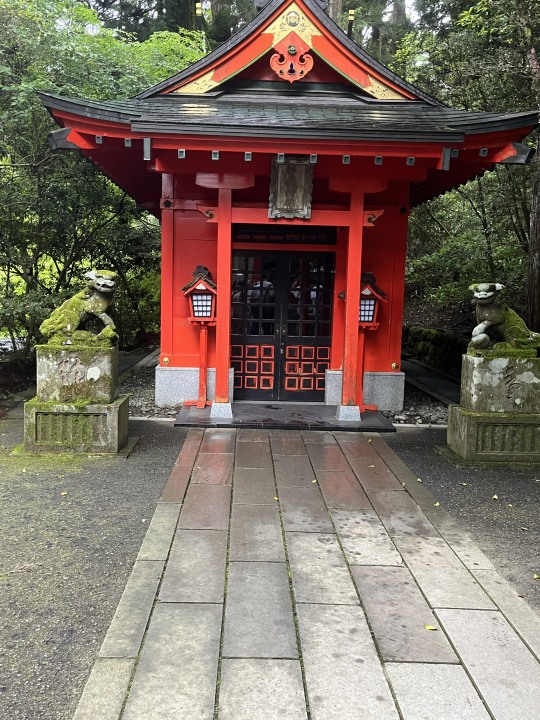
Today we went to Hakone, which is known for their hot springs. I was excited to go since I thought we would have a chance to go into one of the springs, but we ended up not going lol. I still liked the activities that we were able to do today though. Also enjoyed the train ride to and from Hakone; the views were really beautiful. The views that we saw on the other train, cable car, and ship were also amazing. I was a bit scared in the cable car though since I’m not a big fan of heights and the mentioning of potential accidents that could happen also made me a little anxious lol. One thing that I didn’t expect during the day trip was how cold it was. When we reached the Kurotamago store at the end of the cable car, the wind had started blowing pretty bad and teh altitude we were at also made the weather cold. My favorite parts of the Hakone day trip was when we first broke off for lunch and the shrine visit. The place that we went to for luch was a small restaurant ran by two-three people I think. They would make every dish from scratch every time and the vegetable ramen that I had was delicious. I would go back there again; it was a 10/10 for me. I also enjoyed the shrine visit because of some of the history that we learned about it such as the samurai brothers’ dedicated shrine and the markers of emperors would donated to the shrine. I also loved how the shrine was an embodiment of the wabisabi aesthetic that had become popular at the time. I am also surprised that no one has wanted to clean the shrine in the years that have passed since then, in an effort to keep the traditional look and aesthetic of the shrine. It was also a surprise to see Neon Genesis Evangelion at Hakone as well. I ‘m a fan of the franschise and was really happy that we were able to get close to an essential piece of the show.
The reading made me reflect on the sekisho system and Hakone’s part in it. The sekisho system was a good strategic move on the emperor’s part especially since the daimyo that visited already had to spend so many resources to travel to the capital every other year. When the daimyo were able to go back to their regions, the emperor still had collateral so that the daimyo would be less likely to rebel against him. I’m not surprised that Hakone was one of the more stricter sekishos back then, which is evident through how isolated Hakone is. It would have made watching after the daimyos’ families easier and also more difficult for the families to attempt escapes from their sekisho. It was cool to see the guards’ quarters as well to see more of what the process of living in a sekisho was like. The identification check-in that families would first enter through was smart since daimyo might attempt to switch their wives out for someone else. The guard tower that was at the top of the hill would have also been helpful because it allowed them to see more of the sekisho and to spot any suspicious activity that may have been going on.
0 notes
Text
June 5- Musashi University

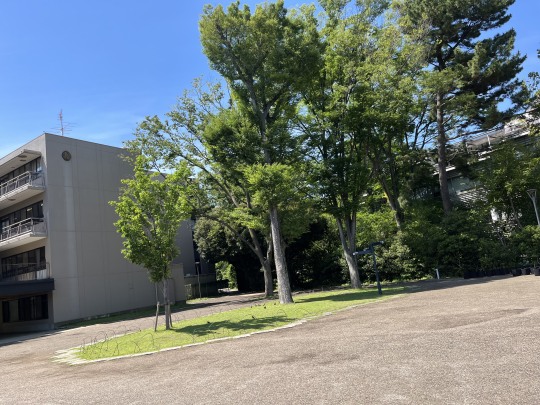
It was cool to interact with Japanese university students today. I appreciated the lecture that the professor gave because it made the conversation with other university students a lot easier. I enjoyed the conversations that we were able to have in the group I was in. I found a few things in common with some of the other students like where we worked and our favorite music genres/artists. During our lunch break, Naomi, Sumi, and I got to talk to one of my group members more. It was nice getting to know her more outside of the activity and learning that she hopes to work abroad and come to Florida one day. The tour around the university was also nice and we got to learn a bit more about the history of the university and its’ other schools. After we were dismissed, I ended up going back to Ginza to explore some more stores with Sumi. We also walked passed a Taylormade store and walked through there. I thought it was interesting to see that store there since my brother, dad, and I all golf using that brand’s products. I didn’t buy anything since most things were too expensive or big to bring with me. I was also finally able to go to the Japanese-Peruvian restaurant with Bianca and Sumi! The food there was delicious and I would go there again. I was happy that they had vegetarian options so I ended up having a quinoa salad, a potato dish, and aguaymanto sorbet. The sorbet was my favorite because it had a mostly sweet but slight tart flavor that I loved. I really enjoyed today mostly because I was able to connect to other students around my age both inside and outside the classroom. Hopefully, I can do another study abroad opportunity before I graduate!
For my group’s discussion topic, we were given Topic A, which mostly focused on immigration and its’ effects. We leaned in the same direction for all the answers that we gave to the discussion. It was interesting to see them reflect on Japan’s strict immigration laws when answering the question on how a nation’s borders may affect culture and tradition. They believe that with Japan’s current laws, the country’s culture and tradition won’t really change due to the lack of external influences from foreigners that would contribute to such change.
For the question about need of passports and other identification, we all said the same thing in that they will always be needed to be able to identify someone and where they are from. We mostly discussed this topic in an emergency context, such as if someone was involved in an accident or another form of crisis that may have occurred.
We weren’t able to discuss the last question about how languages will be affected if national borders didn’t exist, but I still want to answer it since it’s a question that I seen a few times in different contexts. I don’t believe there would be one universal language if borders were to disappear because language will always vary between people in some way. Even if there were a universal language that existed it would eventually be split up into various dialects and create other languages.
0 notes
Text
June 4- Tokyo Tower/Kabuki Theater


Today was enjoyable but these may be my least favorite activities from the trip so far. Tokyo Tower was fun but it was also scary because I’m not the biggest fan of heights. The small glass floor plates were really scary since you could see through to the bottom. I stepped on one of them but came off just as quickly. I saw Naomi and some of my other classmates go on a VR simulator. It didn’t look to be worth it though since all they did was flip people upside down after a few seconds of them looking around the simulation. After the tower, we made our way to Ginza near the Kabuki theater. Giza reminded me of Rodeo Drive or the other luxury streets that you would see in the states because of all the designer brand stores along the street. The kabuki play was interesting, to say the least. I was able to keep up with the first two acts since they were part of our readings but I was a bit lost during the last part. I personally wasn’t a fan of the play since we had to sit for a long period of time. I enjoyed the acting and the costumes though. I enjoyed going to the play for the sake of experiencing it, but I don’t think I would go see another kabuki play anytime soon.
Being able to see from the Tokyo Tower helped me reflect on the Urban Planning reading that we had. I like how simplified Japan’s urban planning system is in how they divided it into three categories. All around Tokyo Tower was commercial area I believe, I don’t think I saw any industrial property in the area. I also like how the Tokyo Tower was built to help provide more coverage to the whole city instead of having to use more property and build more towers like it. Japan’s urban planning is also clever in how they limit the construction of skyscrapers since the building would have to be thinner in order to be taller.
The reading had betrayed my thoughts about kabuki theatre in only a small aspect. I thought that to keep tradition, kabuki theatres would still use only adult men in their plays. The play we had seen featured a couple of children in small roles. This makes sense, since hopefully men wouldn’t be fighting and killing themselves over children anymore. I’m surprised that many theatres don’t allow women to star in these plays though. I understand it would be to keep the onnagata actors, but I would like to see if there is any difference between using an onnagata and a woman in the same role.
0 notes